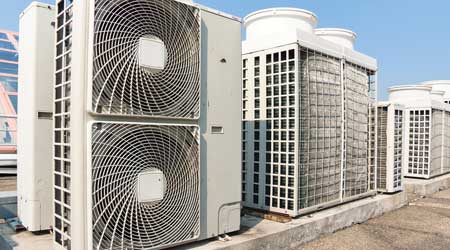Minimizing Energy Use and Saving Money on Utility Bills:
Using cutting-edge technology, VRF systems precisely distribute heating and cooling as and when it’s needed. Variable refrigerant flow (VRF) systems differ from conventional HVAC systems in that they adapt the refrigerant flow to the individual needs of each zone, rather than running at full capacity all the time. Since the system only uses energy where it is really needed, this targeted strategy leads to substantial energy savings.
Additionally, VRF systems have advanced controls that maximize performance depending on factors such as internal loads, outdoor temperature, and occupancy patterns, as well as variable-speed compressors. Businesses can enjoy cheaper utility bills thanks to VRF systems, which continuously adapt to changing conditions and minimize energy consumption. According to research, VRF systems can reduce energy consumption by as much as 30% when compared to traditional HVAC systems.
Zoned Heating and Cooling:
The capacity to create individual temperature zones is a hallmark of variable refrigerant flow (VRF) systems. The inefficiency and discomfort caused by conventional HVAC systems are the consequence of treating the entire building as though it were a single zone. Virtual radiator fan (VRF) technologies, on the other hand, provide zone or room-specific temperature regulation.
Companies can maximize comfort without wasting energy heating or cooling idle spaces by creating separate temperature zones in a facility. Zoning allows for more efficient use of energy by preventing certain areas from being over-conditioned, which improves occupant happiness and leads to substantial savings.
Lower Installation and Maintenance Costs:
Businesses can enjoy long-term cost advantages with VRF systems due to cheaper installation and maintenance requirements, even though the initial investment is higher compared to typical HVAC systems. The installation time and materials costs for VRF systems are reduced since they require smaller ductwork than conventional systems.
In addition to being perfect for new building projects and retrofits, VRF systems’ modular design makes installation simple and expanding easy. Also, compared to conventional HVAC systems, VRF systems have fewer moving components, which means they need less maintenance and have lower operating costs over time. By keeping up with routine servicing and maintenance, VRF systems can last for a long time and run efficiently, reducing the likelihood of expensive repairs or replacements. Because of their durability and dependability, VRF systems are cost-effective in the long run.
Occupant Comfort and Indoor Air Quality Improvements:
IAQ is an important component of a healthy and productive workplace. Problems with indoor air quality (IAQ) can raise absenteeism and reduce productivity in the workplace. By utilizing cutting-edge filtering technology, VRF systems enhance indoor air quality (IAQ) by eliminating airborne pollutants like pollen, dust, and allergies.
Furthermore, VRF systems allow for smooth regulation of indoor climate conditions, including temperature and humidity, resulting in a pleasant interior environment all year round. Maintaining optimum conditions for occupants allows organizations to boost employee satisfaction and productivity, which in turn reduces turnover rates and increases efficiency, resulting to cost savings.
Demand Response Capabilities:
VRF systems can be linked to BAS in order to facilitate capabilities for demand response. Companies frequently launch demand response programs during times of high demand in order to alleviate grid stress. Businesses can temporarily lower their energy consumption and earn financial rewards by joining these schemes.
Because of its real-time modification capabilities, VRF systems are ideal for demand response programs. Whenever the utility company sends indications, like during times of high electricity rates or grid instability, VRF systems that are integrated with BAS can automatically change their operation. Businesses can save money on their power bills and even make money through demand response programs if they cut back on energy use during these peak hours.
Long-Term Return on Investment (ROI):
Businesses can anticipate a long-term return on investment (ROI) from energy savings and lower operating expenses, even if the initial investment in a VRF system may be greater than that of a conventional HVAC system. Total cost of ownership is reduced during the lifetime of a VRF system due to its energy efficiency, zonal control, and demand response capabilities.
It is important for businesses to evaluate the return on investment (ROI) of VRF systems by looking at things like energy savings, utility incentives, decreased maintenance costs, increased occupant comfort, and possible revenue from demand response programs. Businesses can reap substantial financial rewards in the long run from investing in VRF technology if they conduct thorough cost analyses before making any decisions.
Adaptability to Future Needs:
Companies may easily adjust VRF systems to meet their changing needs and usage patterns. It is easy to modify VRF systems to adapt changes in building layout, occupancy levels, or operational requirements without having to invest in new equipment or undergo lengthy reconfiguration.
Improvements in system performance and capacities are also brought about by new developments in VRF technology. Businesses have the opportunity to take advantage of new features and technologies that come out to further improve their HVAC operations and maximize cost savings. Businesses that implement a VRF system set themselves up to take advantage of opportunities and withstand storms in the ever-changing economy.
Long-Term Environmental Protection:
By cutting down on energy usage and emissions of greenhouse gases, VRF systems help promote environmental sustainability in addition to saving money. Businesses can reduce their impact on the environment and meet regulations for energy conservation and environmental responsibility by installing VRF systems, which are known for their high energy efficiency.
Businesses may boost their brand reputation and attract stakeholders and consumers who are environmentally sensitive by using VRF technology, which demonstrates their dedication to sustainability and corporate responsibility. In addition, the world’s initiatives to combat climate change and provide a sustainable future for future generations are consistent with the goal of lowering energy consumption through VRF systems.


